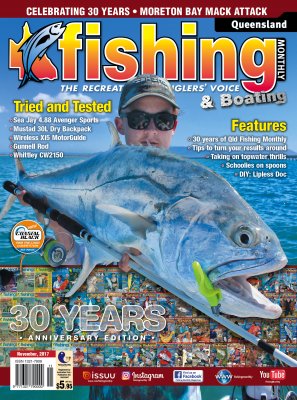Schoolies on spoons by Spero Kartanos
 Some people will tell you there are no fish in Moreton Bay, but I disagree - it's not hard to catch a feed when you know how, and have the time to be there on good fishing days. This is particularly true with such a reliable species as the school mackerel.
Some people will tell you there are no fish in Moreton Bay, but I disagree - it's not hard to catch a feed when you know how, and have the time to be there on good fishing days. This is particularly true with such a reliable species as the school mackerel.
Unlike spotted mackerel, schoolies don't feed on the surface very often (I have seen them on the surface maybe five times in 40 years). What this means is that to catch them, you need to get your lure down to where the fish are. The best way to do this is with a paravane or a diving board.
Lots of anglers who read my Moreton Bay reports (www.reports.fishingmonthly.com.au) see all my photos of schoolies caught trolling, and ask how and where to catch them using this method. I get asked how to attach the line to the board and to the spoon, what fishing gear I use, the time of year, tides and times. So far I have been just emailing people back with advice, or replying on the forum, but I have decided to write a complete article to cover everything.
SPOTTIES AND SCHOOLIES
School mackerel, also called doggy mackerel, can grow up to a metre but are most commonly caught at around 35-80cm. The minimum legal size for schoolies in Queensland is 50cm, and they have an in-possession limit of 10.
These fish are around the same size as spotted mackerel, and to the untrained eye the two species can look similar. However, school mackerel have larger and fewer spots, which are often poorly defined in adults. These bronze-grey blotches are distributed haphazardly and can extend all the way down to the fish's belly. Spotted mackerel, on the other hand, have smaller and more numerous spots, which usually extend no further than two thirds of the way down the fish's side.
Another difference is that a school mackerel's first dorsal fin is black with some areas of white, whereas a spotted mackerel's dorsal fin is blue when it first comes out of the water.
LEARNING CURVE
Pro fishermen have been trolling for pelagics since almost the beginning of time, catching Spanish mackerel, tuna, kingfish and other sought-after species. When I lived in Victoria decades ago, couta fishing was big business, and can still remember the pros trolling with large Smith jigs with two hooks attached, and catching thousands of fish.
The old method for catching school mackerel in Moreton Bay was to anchor up or drift where you thought they were, or where you saw the pros targeting for them, and throw out a pillie and wait. We had some success, but nothing like the consistency of the pros who we'd see methodically going up and down, pulling in one schoolie after another. We found out they were paravaning, and decided to try it.
For this type of fishing you can use either paravanes or trolling boards - they're similar, and are designed to do the same thing. Both have holes at each end, so you can attach the mainline to one end and the leader to the other.
The difference between the trolling boards and paravanes is that paravanes are shaped like a paper plane with a keel, while trolling boards look like a mini surfboard and have no keel.
Whichever one you use (I strongly recommend diving boards for this) the idea is to tie it on above your spoon and troll it. The shape of the paravane or trolling board causes it to quickly dive down, and either shimmy or sway from side to side. It drags your spoon down behind it, and its large profile provides an additional visual attractant to predators prowling below.
Once we decided to try paravaning, we went out and bought our first trolling boards, grabbed some 3" Halco and Makka spoons, and off we went. In the early days our results were terrible - we ended up with spinning diving boards and lots of tangles. We had no choice but to use trial and error until, after many unfruitful days, we figured out the technique and achieved very good results. The good catches have continued to this day.